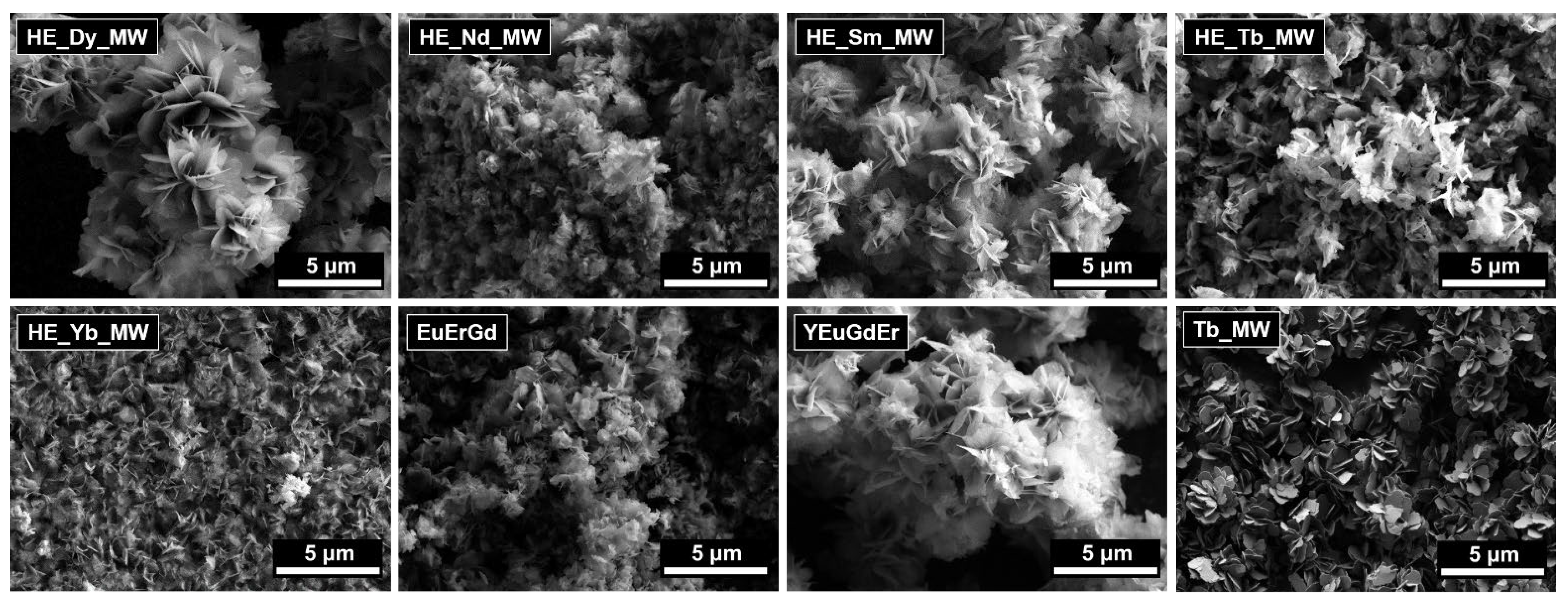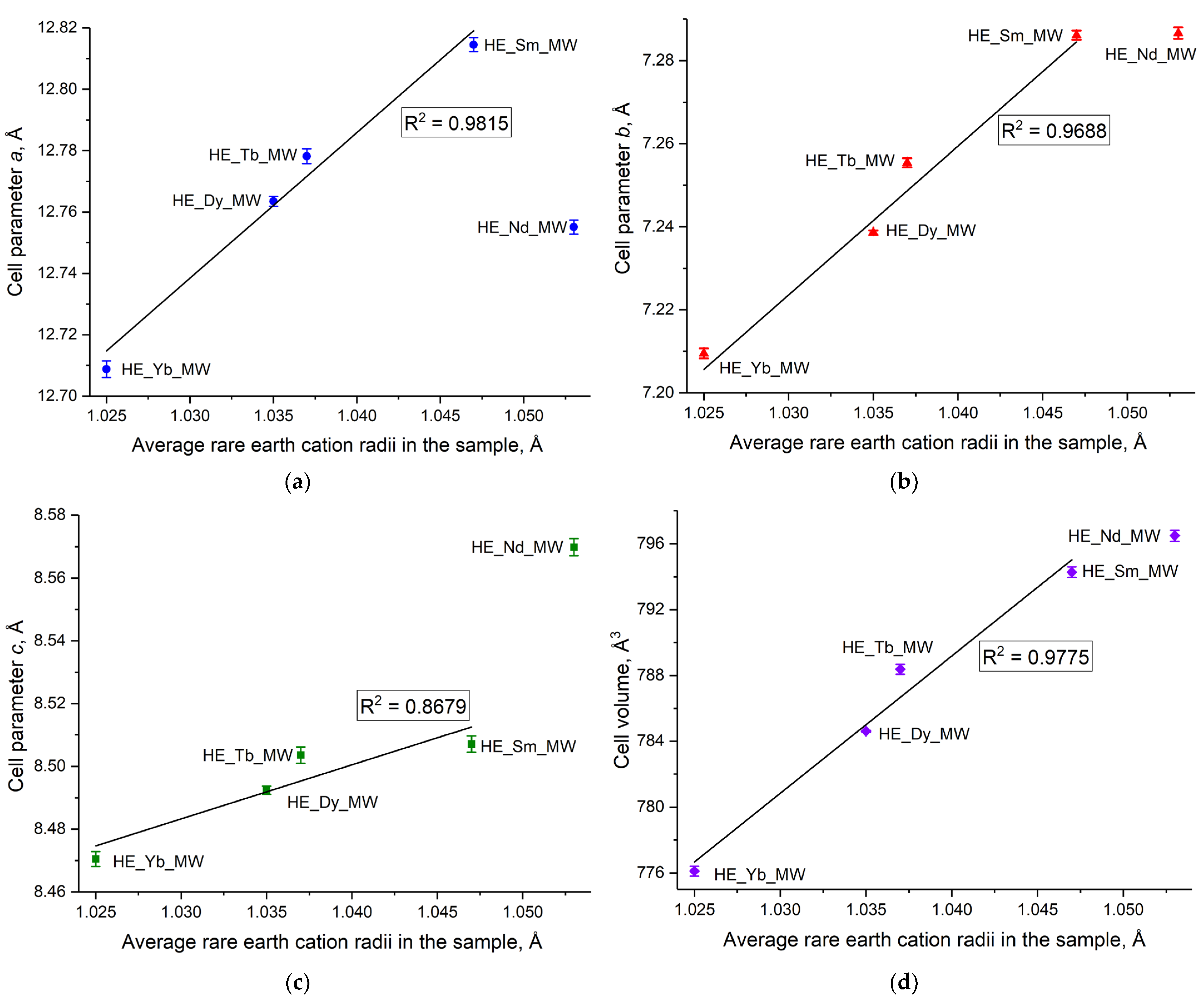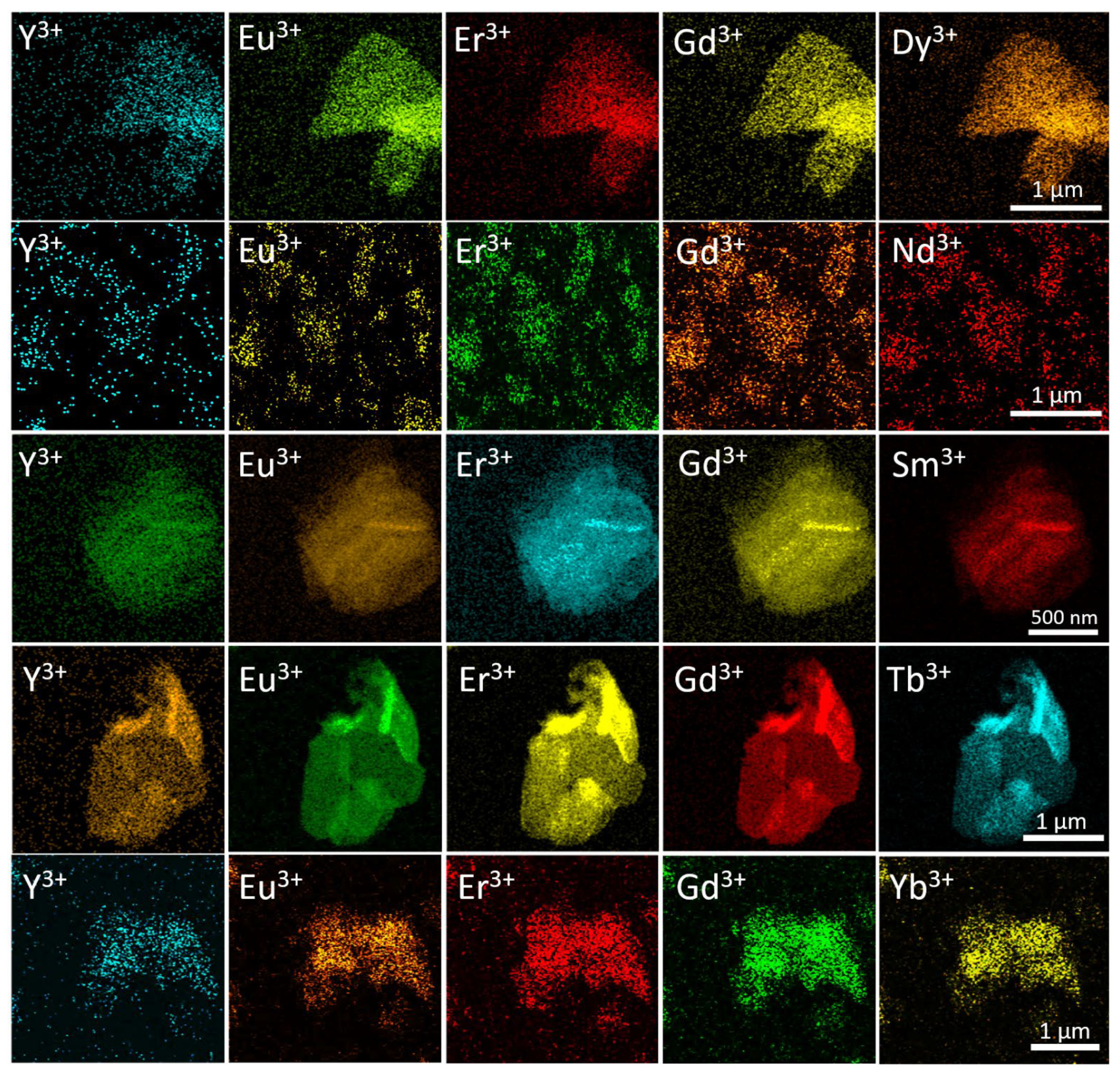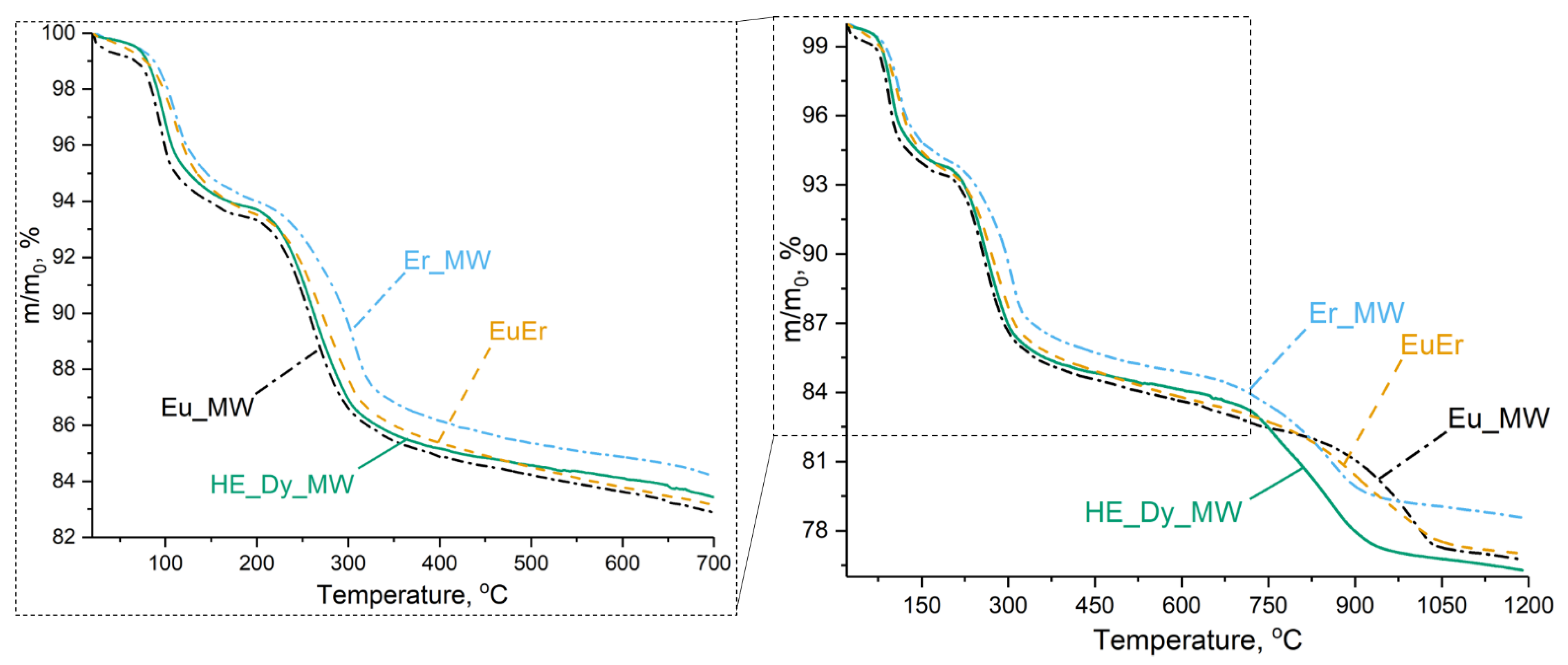Synthesis and Thermal Decomposition of High-Entropy Layered Rare Earth Hydroxychlorides
Abstract
1. Introduction
2. Results and Discussion
2.1. Characterisation of the Synthesised Multicomponent layered Rare Earth Hydroxychlorides
2.2. Calculation of Configurational Entropy
2.3. The Role of Cations: Unit Cell Parameters, REE Distribution, Energy Transfer, and Thermal Stability
3. Materials and Methods
4. Conclusions
Supplementary Materials
Author Contributions
Funding
Institutional Review Board Statement
Informed Consent Statement
Data Availability Statement
Acknowledgments
Conflicts of Interest
References
- Zheng, B.; Fan, J.; Chen, B.; Qin, X.; Wang, J.; Wang, F.; Deng, R.; Liu, X. Rare-Earth Doping in Nanostructured Inorganic Materials. Chem. Rev. 2022, 122, 5519–5603. [Google Scholar] [CrossRef]
- Cantor, B. Multicomponent and High Entropy Alloys. Entropy 2014, 16, 4749–4768. [Google Scholar] [CrossRef]
- Ushakov, S.V.; Hayun, S.; Gong, W.; Navrotsky, A. Thermal Analysis of High Entropy Rare Earth Oxides. Materials 2020, 13, 3141. [Google Scholar] [CrossRef]
- Gelchinski, B.R.; Balyakin, I.A.; Yuryev, A.A.; Rempel, A. High-Entropy Alloys: Properties and Prospects of Application as Protective Coatings. Russ. Chem. Rev. 2022, 91, RCR5023. [Google Scholar] [CrossRef]
- Li, F.; Sun, S.-K.; Chen, Y.; Naka, T.; Hashishin, T.; Maruyama, J.; Abe, H. Bottom-up Synthesis of 2D Layered High-Entropy Transition Metal Hydroxides. Nanoscale Adv. 2022, 4, 2468–2478. [Google Scholar] [CrossRef] [PubMed]
- Nemani, S.K.; Torkamanzadeh, M.; Wyatt, B.C.; Presser, V.; Anasori, B. Functional Two-Dimensional High-Entropy Materials. Commun. Mater. 2023, 4, 16. [Google Scholar] [CrossRef]
- Du, Z.; Wu, C.; Chen, Y.; Cao, Z.; Hu, R.; Zhang, Y.; Gu, J.; Cui, Y.; Chen, H.; Shi, Y.; et al. High-Entropy Atomic Layers of Transition-Metal Carbides (MXenes). Adv. Mater. 2021, 33, 2101473. [Google Scholar] [CrossRef]
- Nemani, S.K.; Zhang, B.; Wyatt, B.C.; Hood, Z.D.; Manna, S.; Khaledialidusti, R.; Hong, W.; Sternberg, M.G.; Sankaranarayanan, S.K.R.S.; Anasori, B. High-Entropy 2D Carbide MXenes: TiVNbMoC3 and TiVCrMoC3. ACS Nano 2021, 15, 12815–12825. [Google Scholar] [CrossRef] [PubMed]
- Wang, R.; Huang, J.; Zhang, X.; Han, J.; Zhang, Z.; Gao, T.; Xu, L.; Liu, S.; Xu, P.; Song, B. Two-Dimensional High-Entropy Metal Phosphorus Trichalcogenides for Enhanced Hydrogen Evolution Reaction. ACS Nano 2022, 16, 3593–3603. [Google Scholar] [CrossRef] [PubMed]
- Li, F.; Kannari, N.; Maruyama, J.; Sato, K.; Abe, H. Defective Multi-Element Hydroxides Nanosheets for Rapid Removal of Anionic Organic Dyes from Water and Oxygen Evolution Reaction. J. Hazard. Mater. 2023, 447, 130803. [Google Scholar] [CrossRef] [PubMed]
- Knorpp, A.J.; Zawisza, A.; Huangfu, S.; Borzì, A.; Clark, A.H.; Kata, D.; Graule, T.; Stuer, M. Hydrothermal Synthesis of Multi-Cationic High-Entropy Layered Double Hydroxides. RSC Adv. 2022, 12, 26362–26371. [Google Scholar] [CrossRef] [PubMed]
- Tichit, D.; Ribet, S.; Coq, B. Characterization of Calcined and Reduced Multi-Component Co-Ni-Mg-Al-Layered Double Hydroxides. Eur. J. Inorg. Chem. 2001, 2001, 539–546. [Google Scholar] [CrossRef]
- Sarkarat, M.; Komarneni, S.; Rezvani, Z.; Wu, X.; Yin, S.; TsugioSato; Yan, Z.F. Multi-Cationic Layered Double Hydroxides: Calcined Products as Photocatalysts for Decomposition of NOx. Appl. Clay Sci. 2013, 80–81, 390–397. [Google Scholar] [CrossRef]
- Wu, H.; Lu, Q.; Li, Y.; Zhao, M.; Wang, J.; Li, Y.; Zhang, J.; Zheng, X.; Han, X.; Zhao, N.; et al. Structural Framework-Guided Universal Design of High-Entropy Compounds for Efficient Energy Catalysis. J. Am. Chem. Soc. 2023, 145, 1924–1935. [Google Scholar] [CrossRef] [PubMed]
- Pavel, O.D.; Tichit, D.; Marcu, I.C. Acido-Basic and Catalytic Properties of Transition-Metal Containing Mg-Al Hydrotalcites and Their Corresponding Mixed Oxides. Appl. Clay Sci. 2012, 61, 52–58. [Google Scholar] [CrossRef]
- Miura, A.; Ishiyama, S.; Kubo, D.; Rosero-Navarro, N.C.; Tadanaga, K. Synthesis and Ionic Conductivity of a High-Entropy Layered Hydroxide. J. Ceram. Soc. Jpn. 2020, 128, 336–339. [Google Scholar] [CrossRef]
- Seliverstov, E.S.; Golovin, S.N.; Lebedeva, O.E. Layered Double Hydroxides Containing Rare Earth Cations: Synthesis and Applications. Front. Chem. Eng. 2022, 4, 867615. [Google Scholar] [CrossRef]
- Yapryntsev, A.D.; Baranchikov, A.E.; Ivanov, V.K. Layered Rare-Earth Hydroxides: A New Family of Anion-Exchangeable Layered Inorganic Materials. Russ. Chem. Rev. 2020, 89, 629–666. [Google Scholar] [CrossRef]
- Teplonogova, M.A.; Yapryntsev, A.D.; Baranchikov, A.E.; Ivanov, V.K. High-Entropy Layered Rare Earth Hydroxides. Inorg. Chem. 2022, 61, 19817–19827. [Google Scholar] [CrossRef] [PubMed]
- Feng, Z.; Xiao, D.; Liu, Z.; Hou, G.; Xu, J. “X Factor” in the Structure and Anion Exchange of Layered Yttrium Hydroxides. J. Phys. Chem. C 2021, 125, 7251–7258. [Google Scholar] [CrossRef]
- Knorpp, A.J.; Allegri, P.; Huangfu, S.; Vogel, A.; Stuer, M. Synthesis and Characterization of High-Entropy Dawsonite-Type Structures. Inorg. Chem. 2023, 62, 4999–5007. [Google Scholar] [CrossRef] [PubMed]
- Han, J.; Guan, J. Multicomponent Transition Metal Oxides and (Oxy)Hydroxides for Oxygen Evolution. Nano Res. 2023, 16, 1913–1966. [Google Scholar] [CrossRef]
- Geng, F.; Matsushita, Y.; Ma, R.; Xin, H.; Tanaka, M.; Izumi, F.; Iyi, N.; Sasaki, T. General Synthesis and Structural Evolution of a Layered Family of Ln8(OH)20Cl4·nH2O (Ln = Nd, Sm, Eu, Gd, Tb, Dy, Ho, Er, Tm, and Y). J. Am. Chem. Soc. 2008, 130, 16344–16350. [Google Scholar] [CrossRef] [PubMed]
- Mahjoubi, F.Z.; Khalidi, A.; Abdennouri, M. Zn–Al Layered Double Hydroxides Intercalated with Carbonate, Nitrate, Chloride and Sulphate Ions: Synthesis, Characterisation and Dye Removal Properties. Integr. Med. Res. 2018, 11, 90–100. [Google Scholar] [CrossRef]
- Socrates, G.; Tammer, M. Infrared and Raman Characteristic Group Frequencies: Tables and Charts, 3rd ed.; John Wiley & Sons, Inc.: Chichester, UK, 2001; Volume 283, ISBN 0303-402X. [Google Scholar]
- Shannon, R.D.; Prewitt, C.T. Effective Ionic Radii in Oxides and Fluorides. Acta Crystallogr. Sect. B Struct. Crystallogr. Cryst. Chem. 1969, 25, 925–946. [Google Scholar] [CrossRef]
- Yapryntsev, A.D.; Baranchikov, A.E.; Skogareva, L.S.; Goldt, A.E.; Stolyarov, I.P.; Ivanova, O.S.; Kozik, V.V.; Ivanov, V.K. High-Yield Microwave Synthesis of Layered Y2(OH)5NO3*xH2O Materials. CrystEngComm 2015, 17, 2667–2674. [Google Scholar] [CrossRef]
- Yeh, J.W.; Lin, S.J. Breakthrough Applications of High-Entropy Materials. J. Mater. Res. 2018, 33, 3129–3137. [Google Scholar] [CrossRef]
- Murty, B.S.; Yeh, J.W.; Ranganathan, S.; Bhattacharjee, P.P. High-Entropy Alloys, 2nd ed.; Elsevier: Amsterdam, The Netherlands, 2019; ISBN 978-0-12-816067-1. [Google Scholar]
- Binnemans, K. Interpretation of Europium(III) Spectra. Coord. Chem. Rev. 2015, 295, 1–45. [Google Scholar] [CrossRef]
- Lee, B.-I.; Jeong, H.; Byeon, S.-H. Oxychloride–Hydroxychloride–Trihydroxide Phase Relationships of Rare Earths in Aqueous Solution. Inorg. Chem. 2014, 53, 5212–5221. [Google Scholar] [CrossRef]
- Benito, P.; Herrero, M.; Barriga, C.; Labajos, F.M.; Rives, V. Microwave-Assisted Homogeneous Precipitation of Hydrotalcites by Urea Hydrolysis. Inorg. Chem. 2008, 47, 5453–5463. [Google Scholar] [CrossRef] [PubMed]
- Geng, F.; Matsushita, Y.; Ma, R.; Xin, H.; Tanaka, M.; Iyi, N.; Sasaki, T. Synthesis and Properties of Well-Crystallized Layered Rare-Earth Hydroxide Nitrates from Homogeneous Precipitation. Inorg. Chem. 2009, 48, 6724–6730. [Google Scholar] [CrossRef] [PubMed]
- Yapryntsev, A.; Abdusatorov, B.; Yakushev, I.; Svetogorov, R.; Gavrikov, A.; Rodina, A.; Fatyushina, Y.; Baranchikov, A.; Zubavichus, Y.; Ivanov, V. Eu-Doped Layered Yttrium Hydroxides Sensitized by a Series of Benzenedicarboxylate and Sulphobenzoate Anions. Dalt. Trans. 2019, 48, 6111–6122. [Google Scholar] [CrossRef] [PubMed]
- Yapryntsev, A.D.; Baranchikov, A.E.; Zabolotskaya, A.V.; Borilo, L.P.; Ivanov, V.K. Synthesis of Gadolinium Hydroxo Nitrate under Microwave-Hydrothermal Treatment Conditions. Russ. J. Inorg. Chem. 2014, 59, 1383–1391. [Google Scholar] [CrossRef]
- Yapryntsev, A.; Baranchikov, A.; Goldt, A.; Ivanov, V. Microwave-Assisted Hydrothermal Synthesis of Layered Europium Hydroxynynitrate, Eu2(OH)5NO3∙xH2O. Curr. Microw. Chem. 2015, 3, 3–8. [Google Scholar] [CrossRef]
- Wojdyr, M. Fityk: A General-Purpose Peak Fitting Program. J. Appl. Crystallogr. 2010, 43, 1126–1128. [Google Scholar] [CrossRef]






| Cation | Sample | ||||||
|---|---|---|---|---|---|---|---|
| HE_Dy_MW | HE_Nd_MW | HE_Sm_MW | HE_Tb_MW | HE_Yb_MW | YEuErGd | EuErGd | |
| Eu3+ | 18.1 | 22.6 | 20.4 | 21.3 | 19.9 | 26.1 | 35.0 |
| Gd3+ | 19.0 | 21.3 | 19.5 | 20.2 | 13.5 | 24.9 | 33.3 |
| Er3+ | 20.0 | 22.2 | 19.5 | 19.8 | 21.4 | 23.6 | 31.7 |
| Y3+ | 23.0 | 17.3 | 21.5 | 18.9 | 24.0 | 25.4 | |
| Dy3+ | 19.9 | ||||||
| Nd3+ | 16.6 | ||||||
| Sm3+ | 19.1 | ||||||
| Tb3+ | 19.8 | ||||||
| Yb3+ | 21.2 | ||||||
| theoretical | 20.0 | 25.0 | 33.3 | ||||
| Sample | Raverage, Å | ∆r, % |
|---|---|---|
| HE_Nd_MW | 1.053 | 11.4 |
| HE_Sm_MW | 1.047 | 8.6 |
| HE_Tb_MW | 1.037 | 6.8 |
| HE_Dy_MW | 1.035 | 6.8 |
| HE_Yb_MW | 1.025 | 8.8 |
| YEuGdEr | 1.036 | 6.8 |
| EuErGd | 1.043 | 6.7 |
| EuEr | 1.035 | 6.8 |
| Eu_MW | 1.07 | 0 |
| Er_MW | 1.00 | 0 |
| Sample | ΔSconf, R |
|---|---|
| HE_Nd_MW | 1.60 |
| HE_Sm_MW | 1.61 |
| HE_Tb_MW | 1.61 |
| HE_Dy_MW | 1.61 |
| HE_Yb_MW | 1.59 |
| YEuGdEr | 1.39 |
| EuErGd | 1.10 |
Disclaimer/Publisher’s Note: The statements, opinions and data contained in all publications are solely those of the individual author(s) and contributor(s) and not of MDPI and/or the editor(s). MDPI and/or the editor(s) disclaim responsibility for any injury to people or property resulting from any ideas, methods, instructions or products referred to in the content. |
© 2024 by the authors. Licensee MDPI, Basel, Switzerland. This article is an open access article distributed under the terms and conditions of the Creative Commons Attribution (CC BY) license (https://creativecommons.org/licenses/by/4.0/).
Share and Cite
Teplonogova, M.A.; Kozlova, A.A.; Yapryntsev, A.D.; Baranchikov, A.E.; Ivanov, V.K. Synthesis and Thermal Decomposition of High-Entropy Layered Rare Earth Hydroxychlorides. Molecules 2024, 29, 1634. https://doi.org/10.3390/molecules29071634
Teplonogova MA, Kozlova AA, Yapryntsev AD, Baranchikov AE, Ivanov VK. Synthesis and Thermal Decomposition of High-Entropy Layered Rare Earth Hydroxychlorides. Molecules. 2024; 29(7):1634. https://doi.org/10.3390/molecules29071634
Chicago/Turabian StyleTeplonogova, Maria A., Anfisa A. Kozlova, Alexey D. Yapryntsev, Alexander E. Baranchikov, and Vladimir K. Ivanov. 2024. "Synthesis and Thermal Decomposition of High-Entropy Layered Rare Earth Hydroxychlorides" Molecules 29, no. 7: 1634. https://doi.org/10.3390/molecules29071634
APA StyleTeplonogova, M. A., Kozlova, A. A., Yapryntsev, A. D., Baranchikov, A. E., & Ivanov, V. K. (2024). Synthesis and Thermal Decomposition of High-Entropy Layered Rare Earth Hydroxychlorides. Molecules, 29(7), 1634. https://doi.org/10.3390/molecules29071634









